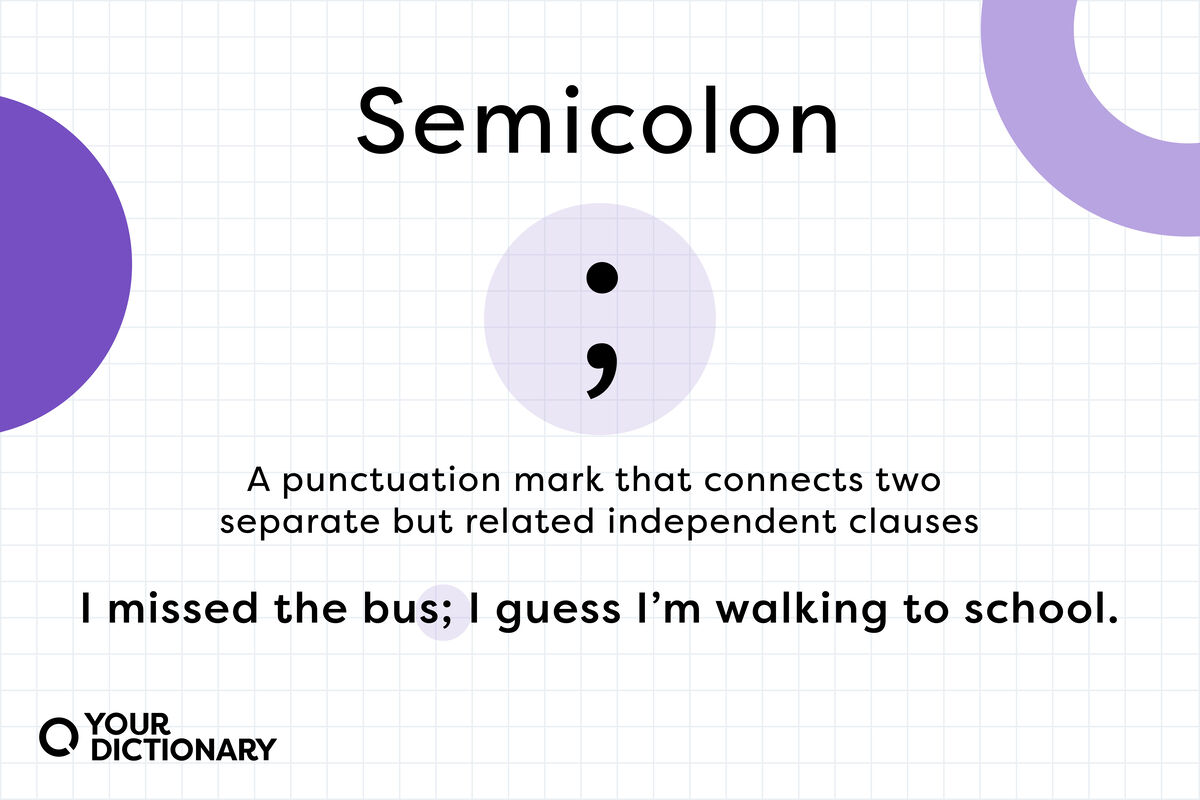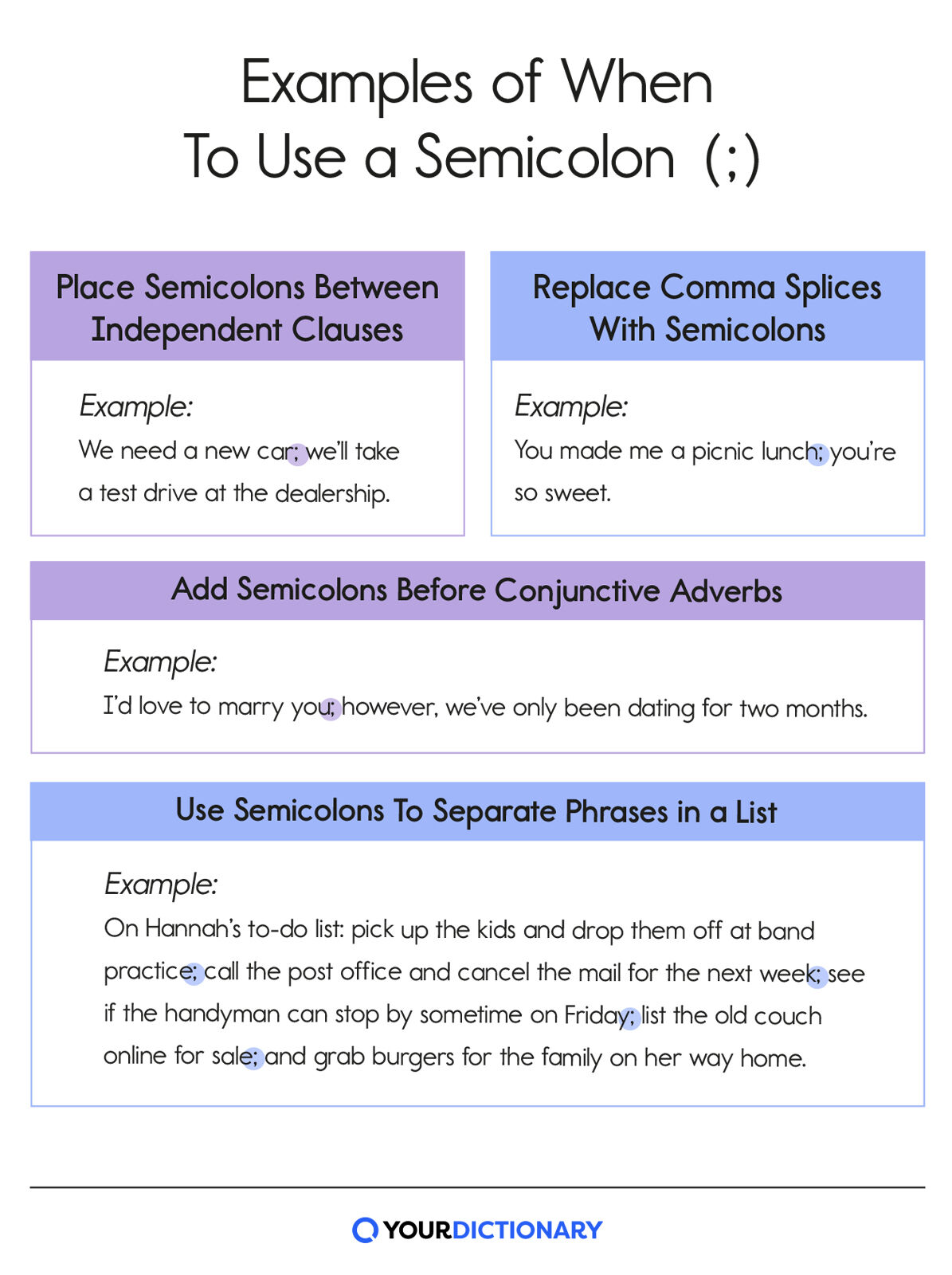
A semicolon (;) is a punctuation mark that connects two separate but related thoughts. They indicate a longer pause than a comma provides in a sentence, but a shorter pause than a colon.
There’s one main semicolon rule to remember: When used in a sentence, each side of the semicolon must include an independent clause (a full sentence). Otherwise, the sentence isn’t grammatically correct.
Capitalizing After a Semicolon
You shouldn't capitalize the word after a semicolon unless it’s a proper noun.
Just like with coordinating conjunctions, a semicolon creates a sentence with two parts.
- I live in Arkansas; my best friend lives in Utah. (Don’t capitalize)
- I live in Arkansas; Nora lives in Utah. (Only capitalize because Nora is a proper noun)
Semicolon Examples
When two sentences are closely related, separating them with a period may seem too harsh. That’s where semicolons come in handy.
You’ll usually find semicolons in compound sentences, though skillful writers may use them in other sentence types too.
- I missed the bus; I guess I’m walking to school.
- We’d love to hire you; however, we need a few more documents.
- The restaurant was booked; John got us a table anyway.
- My sister called this morning; unfortunately, I missed the call.
- Paula loves football; her husband prefers soccer.
When To Use a Semicolon
Semicolons are helpful in sentences when you want to:
- join independent clauses in a sentence
- fix comma splices
- use conjunctive adverbs in a sentence
- define parts of a list in a clearer way
It's important to get the details right when using semicolons in a sentence so that the reader doesn't find it jarring when a semicolon is added to a sentence.

Place Semicolons Between Independent Clauses
The most common way to use a semicolon is to separate independent clauses. They can replace coordinating conjunctions (for, and, nor, but, or, yet, so) to connect two complete thoughts that are closely related.
- We need a new car, so we’ll take a test drive at the dealership.
- We need a new car; we’ll take a test drive at the dealership.
- My mother grew up in Alaska, and she’s always wanted to go back.
- My mother grew up in Alaska; she’s always wanted to go back.
Note that you never use coordinating conjunctions with semicolons. Use them separately — and if the sentence makes more sense with the conjunction, feel free to use it instead of the semicolon.
Replace Comma Splices With Semicolons
A comma splice is a common grammatical error where a comma is connecting two independent clauses, which it’s not supposed to do. An easy way to fix a comma splice is to make the comma into a semicolon (if the sentences are somewhat related).
- You made me a picnic lunch, you’re so sweet. (Comma splice)
- You made me a picnic lunch; you’re so sweet. (Correct)
- That dress is gorgeous, I must have it. (Comma splice)
- That dress is gorgeous; I must have it. (Correct)
Add Semicolons Before Conjunctive Adverbs
Another way to use semicolons is just before a conjunctive adverb (however, unfortunately, therefore). Like semicolons, conjunctive adverbs also connect related independent clauses, and using them together can smooth out choppy sentences.
- I’d love to marry you. However, we’ve only been dating for two months. (Choppy)
- I’d love to marry you; however, we’ve only been dating for two months. (Smoother)
- We’re out of milk. Unfortunately, Fred forgot to get some at the store. (Choppy)
- We’re out of milk; unfortunately, Fred forgot to get some at the store. (Smoother)
Use Semicolons To Separate Phrases in a List
You can also use semicolons instead of commas in serial lists with longer phrases (or phrases that already have commas) to avoid confusion.
- I’ve lived in many cities, including Atlanta, Georgia; Paris, France; Los Angeles, California; and Boise, Idaho.
- On Hannah’s to-do list: pick up the kids and drop them off at band practice; call the post office and cancel the mail for the next week; see if the handyman can stop by sometime on Friday; list the old couch online for sale; and grab burgers for the family on her way home.
Semicolons vs. Colons
Even though semicolons and colons share part of their name, they don’t function in the same way.
Colons connect very strongly related ideas (usually part of the same sentence), or show emphasis to a second idea. Additionally, a colon can come before incomplete thoughts or even single words.
- We need to bring the following: bread, meat, tomatoes, and lettuce.
- Don’t tell me: You’re not coming.
Notice another difference between semicolons and colons? You should capitalize the first letter after a colon if it’s an independent clause, according to AP and APA style guides.
Semicolons vs. Em Dashes
Semicolons aren’t the only punctuation mark where usage gets a little fuzzy. Many writers replace semicolons with em dashes (—), particularly when they want to add emphasis to part of a sentence. Is that okay?
Remember the primary semicolon rule: They separate independent clauses. If you want to add a longer, more sudden pause to this separation, feel free to replace a semicolon with an em dash.
- There was a knock at the door; Drew looked up in alarm. (Correct)
- There was a knock at the door — Drew looked up in alarm. (More dramatic)
But that’s the only time when semicolons and em dashes are interchangeable. Using a semicolon instead of an em dash isn’t grammatically correct in any other context.
- He wasn’t supposed to open the door for strangers — especially when his parents weren’t home. (Correct)
- He wasn’t supposed to open the door for strangers; especially when his parents weren’t home. (Incorrect — the second clause is a subordinate clause, not an independent clause)
Use Semicolons Semi-Often
Semicolons and em dashes have one more thing in common: You shouldn’t use them too often.
Lots of semicolons and/or em dashes on a page mean that you’re not actually varying your sentences that much, which is the whole point of using them in the first place.
Avoid using more than one or two semicolons or em dashes per page (and definitely never more than one per paragraph). Otherwise, they can get repetitive and annoying, rather than stylistic and purposeful.
Fast Fact
The semicolon was created during the Italian Renaissance by 15th-century publisher Aldus Manutius, who paired the comma and colon on his printing press in Pietro Bembo’s Latin essay De Aetna.
The semicolon became popular throughout Europe due to its simplicity and function, outlasting many other Renaissance-era punctuation marks (including the sarcastic punctus percontativus).